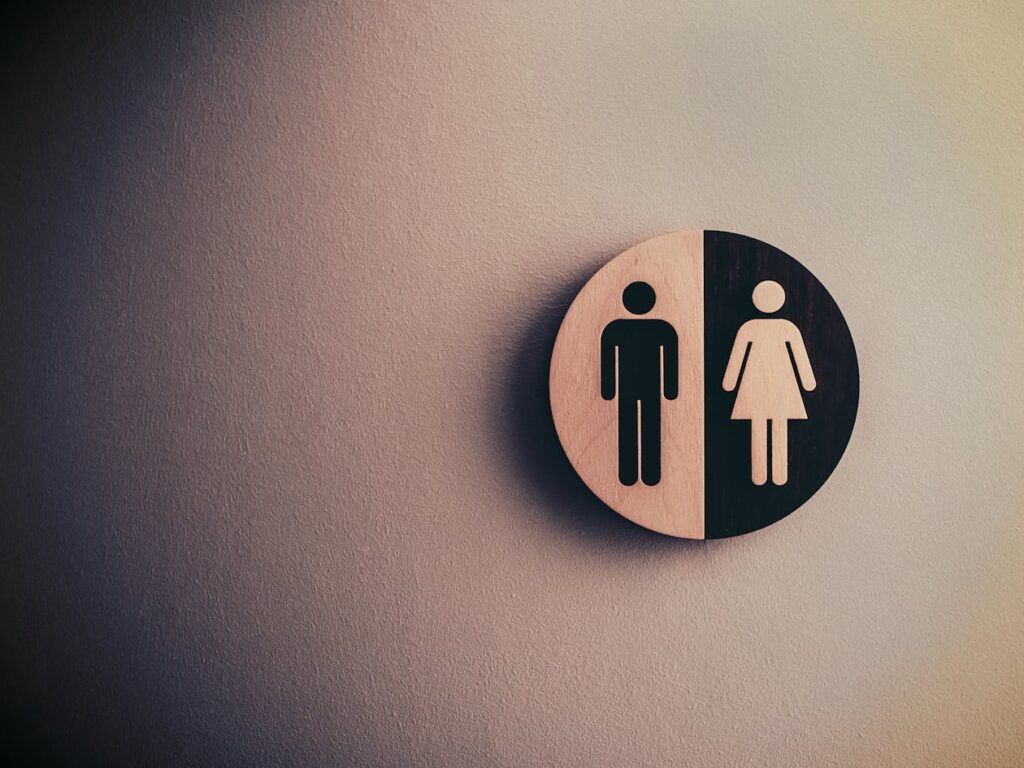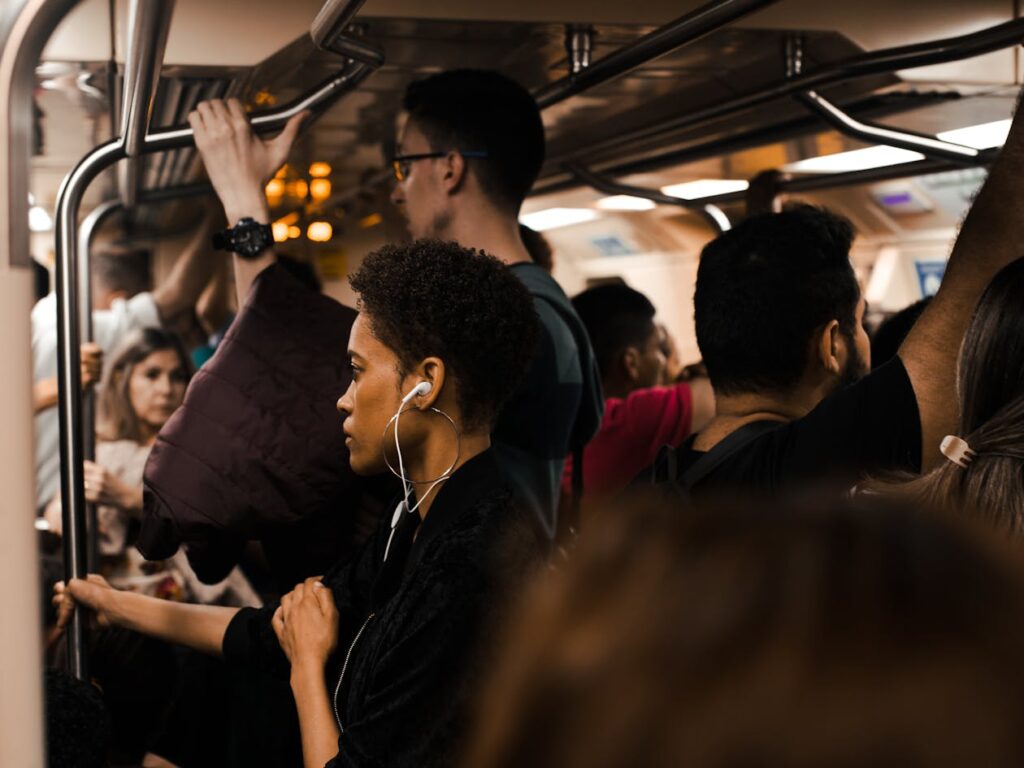Should Men Give Up Their Seats on Public Transport for Women? Battle Breaks Out Over Londoner’s Viral Clip

Something happened on a London Underground train that would spark one of the most heated debates of the year. A woman pulled out her phone during her daily commute and captured something that millions would see. What she recorded seemed ordinary at first glance – just another crowded carriage during rush hour. But what happened next divided the internet like few social issues ever have.
Comments sections exploded. Battle lines formed. Women shared their own stories of frustration. Men defended their actions with equal passion. Social media platforms became battlegrounds where strangers argued about respect, equality, and what modern society owes to each other.
What could possibly cause such fierce division? What everyday scene could ignite debates that reached across continents and generations? What simple moment could make people question everything they believed about courtesy, gender roles, and public behavior?
A ordinary commute became a viral sensation that would challenge assumptions, expose hidden tensions, and force everyone to examine their own behavior on public transport. But nobody was prepared for how personal this fight would become.
One TikTok Clip Changes Everything: Video That Broke the Internet
@annibaxter filmed what she saw on the Central line during her regular commute. Her camera captured a whole row of men sitting comfortably while women stood in the aisle, gripping poles for balance as the train rocked through London’s underground tunnels. She added Lorde’s “Man of the Year” as soundtrack – a sarcastic musical commentary on what she witnessed.
Her unimpressed expression said everything words couldn’t. Here was visual evidence of something many women experienced daily but rarely documented. Men occupying seats while women stood, apparently without consideration for traditional courtesy expectations.
Within days, the video exploded across social media platforms. Over 1.4 million people liked the clip. Thousands shared their own experiences. Comments sections filled with heated arguments about gender, equality, and public behavior.
@annibaxter disabled comments on her original video, but discussion spread everywhere else. Women began posting their own footage from London transport, showing similar patterns. What started as one person’s observation became a movement documenting everyday experiences on public transport.
Women Fight Back: Stories From Underground Battlefield
@catlouisemx shared her own Jubilee line experience, showing another row of seats occupied entirely by men while she and female friends stood nearby. Her caption cut straight to the heart of many women’s frustration: “Men used to go to war for us and now we can’t even get a man to let us sit down on the train.”
Rayana Alyssa posted similar footage with her own pointed commentary: “2024 is the end of chivalry. And the era of men running for seats on the tube…” Her video showed nearly all seats taken by men, with women standing in spaces between carriages.
Women flooded social media with personal accounts of transport experiences. Stories emerged of men actively racing to seats, pushing past women to claim available spots. Some reported being physically shoved aside by men determined to sit down first.
X users documented escalating competition for seats. Women described grown men running through carriages to claim empty spots before women could reach them. What once might have been polite consideration had apparently transformed into aggressive competition.
Racing to Bottom: When Men Push Women for Seats

Reports surfaced of men physically pushing women aside to reach available seats. Social media users shared experiences of being shoved, elbowed, and rushed past by men seeking seating priority on London transport.
One X user described being pushed out of the way by a man grabbing a seat, despite her only having two stops remaining. Another reported being physically shoved by a man even when multiple seats were available throughout the carriage.
Women documented patterns of men “scramming” for seats with apparent desperation. Behavior that seemed unnecessarily aggressive for simple commuter situations. Rushing, pushing, and competing for seating became common enough to generate widespread online discussion.
Social media users expressed bewilderment at the intensity men displayed while pursuing seats. Behavior that seemed disproportionate to the minor inconvenience of standing during short journeys. Questions arose about what motivated such aggressive pursuit of seating comfort.
Crutches, Pregnancy, and Invisible Struggles
Reddit discussions revealed deeper patterns in public transport behavior. A woman recovering from a cycling accident spent 10 weeks using crutches on London transport. Her experience illuminated consistent patterns in who offered assistance versus who looked away.
Women consistently offered help throughout her recovery period. Elderly women, mothers carrying children, and female passengers regularly gave up their seats despite their own potential discomfort. Men, regardless of age, typically ignored her obvious need for seating support.
She described men looking her up and down, clearly seeing her struggle with crutches, then deliberately avoiding eye contact or hiding their faces when she politely requested assistance. Behavior suggesting awareness of her situation combined with conscious decisions to avoid helping.
Another woman shared experiences during late pregnancy. After standing for 20 minutes on a crowded train, a young girl finally offered her seat. Adult men throughout the carriage had avoided acknowledging her obvious need for seating support during her ninth month of pregnancy.
Equality Pushback: Men Defend Their Right to Sit

Male voices pushed back against expectations of automatic courtesy toward women. Many argued that gender equality meant equal treatment in all situations, including public transport seating arrangements.
TikTok users defended their seating choices by citing equal rights principles. One man stated his position clearly: “You equal woman can stand up just like I would if there were no seats.” His comment reflected broader sentiment among men who rejected gender-based courtesy expectations.
Men argued they would offer seats to pregnant women, elderly passengers, or disabled individuals, but rejected giving up seats based solely on gender. Many viewed such expectations as outdated and incompatible with contemporary equality principles.
Some men expressed frustration with being criticized for behaviors they considered fair and equal. Arguments emerged about first-come, first-served principles versus gender-based priority systems. Men questioned why their comfort should be automatically sacrificed for women who weren’t demonstrably more needy.
Women Divided: Not All Sisters Stand Together
Female voices joined the pushback against expectation of male courtesy. Some women rejected the idea that men should automatically offer seats to women who weren’t pregnant, elderly, or disabled.
Comments sections filled with women defending men’s right to keep seats they claimed first. Some argued that expecting special treatment based on gender contradicted feminist principles of equality and independence.
Generational differences emerged among women responding to the controversy. Younger women seemed more likely to reject traditional courtesy expectations, while older women expressed disappointment with declining chivalrous behavior.
Women debated whether accepting seat offers reinforced gender stereotypes or simply represented practical courtesy. Discussions revealed complex feelings about independence, equality, and traditional gender roles in modern society.
From Chivalry to Competition: How Transport Became Battleground

Historical expectations of male courtesy toward women evolved significantly over recent decades. Traditional chivalry involved men protecting and assisting women in public spaces, including offering seats on transport.
Contemporary equality movements challenged gender-based special treatment as potentially patronizing or reinforcing stereotypes about female weakness. Many women rejected traditional courtesy as incompatible with independence and equal treatment expectations.
London Underground became a daily testing ground for evolving social norms. Millions of interactions occurred between strangers navigating competing expectations about courtesy, equality, and public behavior.
Daily commutes revealed deeper cultural tensions about gender roles, social responsibility, and individual rights. Simple seating decisions reflected broader disagreements about how men and women should interact in public spaces.
Real Issue: Respect in Public Spaces
Beyond gender debates lies broader questions about public courtesy and social consideration. How society treats vulnerable members reveals collective values about mutual respect and community responsibility.
Individual actions on public transport reflect personal character and social awareness. Whether someone offers assistance to struggling passengers demonstrates empathy and consideration for others’ wellbeing.
Building respectful public spaces requires recognizing when others need support, regardless of gender. Pregnant passengers, elderly individuals, disabled commuters, and injured travelers all deserve consideration from fellow passengers.
Creating positive transport culture involves moving beyond gender-focused debates toward human-centered approaches emphasizing empathy, awareness, and mutual support during shared experiences.
What Fight Really Reveals About Modern Gender Relations

Transport etiquette debates expose deeper tensions about contemporary gender equality and social expectations. Traditional courtesy models clash with modern equality principles, creating confusion about appropriate behavior.
Generational differences complicate discussions about gender roles and public courtesy. Older expectations about male protectiveness conflict with younger emphasis on equal treatment and independence.
Social media amplifies everyday interactions into broader cultural commentary. Simple commuter behaviors become symbols of larger social changes and gender relationship evolution.
Public behavior reflects private attitudes about gender, respect, and social responsibility. How people treat strangers during brief transport encounters reveals deeper values about community and consideration.
Redefining Courtesy for Modern Times
Moving beyond gender wars requires focusing on human needs rather than gender-based expectations. Courtesy should respond to individual circumstances rather than demographic categories.
Pregnant passengers, elderly commuters, disabled travelers, and injured individuals need seating support regardless of gender. Parents carrying children, people using mobility aids, and visibly struggling passengers deserve consideration from all fellow travelers.
Education about recognizing genuine need could improve public transport experiences for everyone. Teaching awareness of others’ circumstances creates more supportive public spaces without reinforcing gender stereotypes.
Individual actions matter more than viral debates. Choosing kindness, awareness, and consideration during daily commutes builds better communities one interaction at a time. Personal responsibility for creating positive public spaces transcends gender politics and social media arguments.
Creating respectful transport culture requires commitment from all passengers to notice, care, and act when others need support. Simple human decency works better than complex rules about gender-based behavior in shared public spaces.
Loading...

